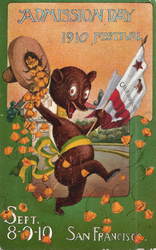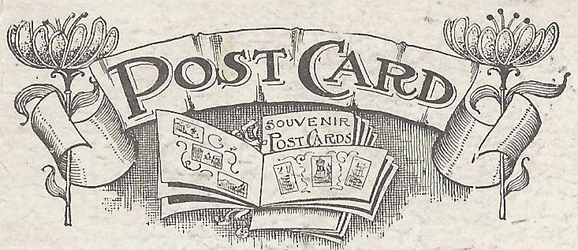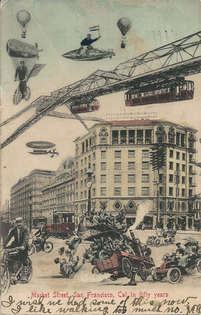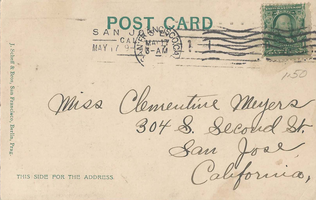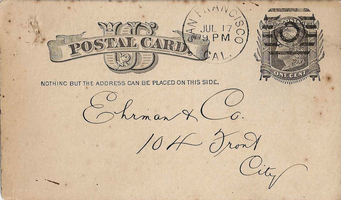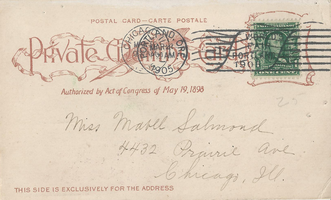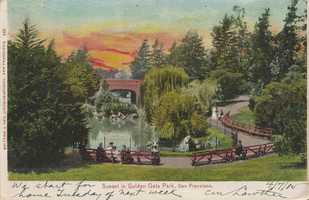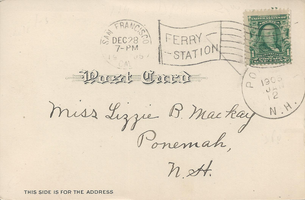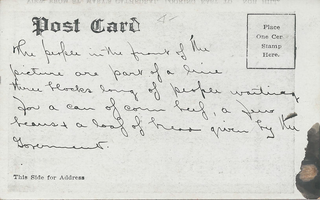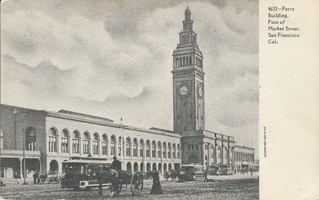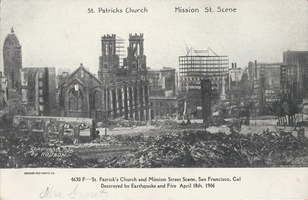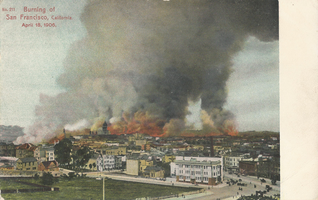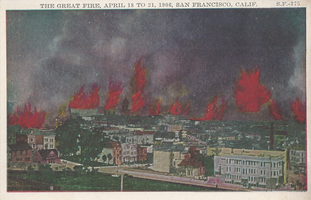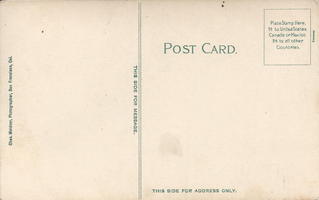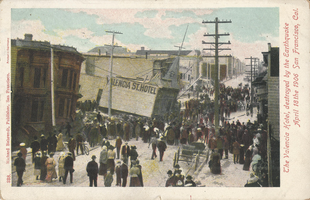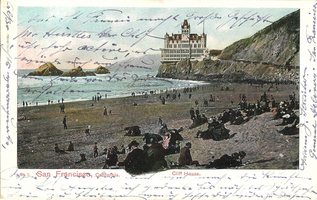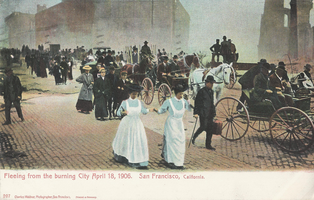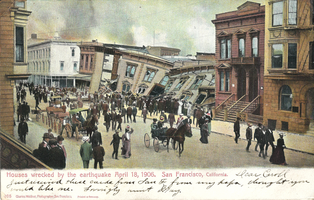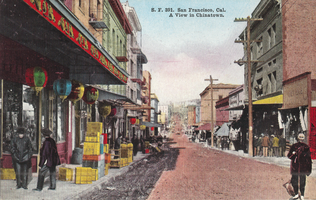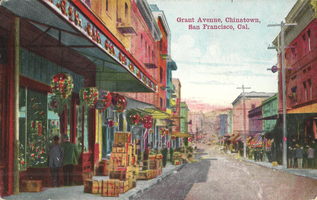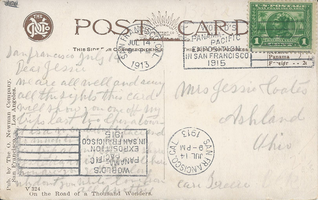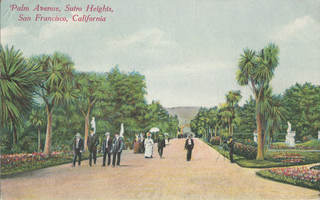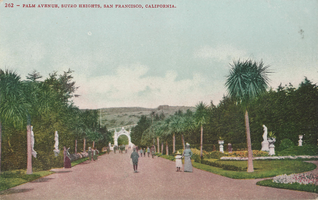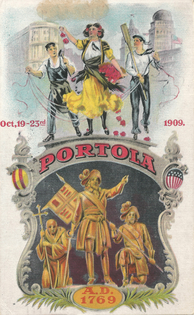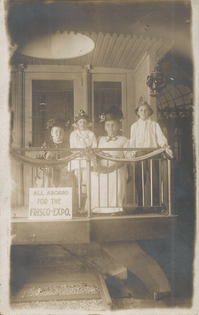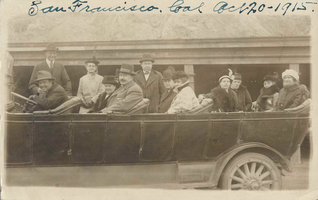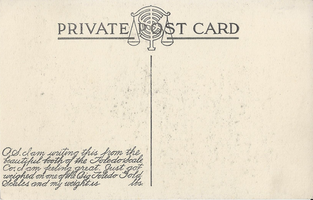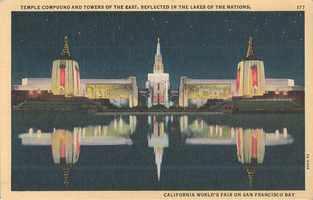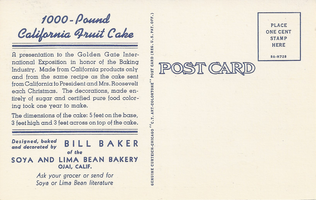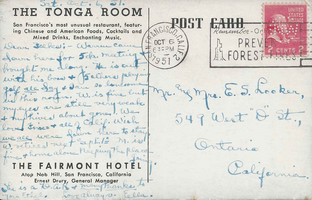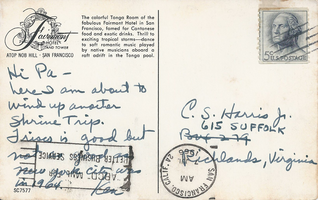I have collected San Franciscana for decades: books, stereoviews, and ephemera, much of it related to the 1906 earthquake and fire. Eventually I stumbled onto a few old postcards, one card led to another, and now my postcard collection includes over a thousand cards, most over a century old. This page gives a brief illustrated introduction to my collection, roughly chronologically. It touches on U.S. postal history and includes a little postcard collector geekery, but it's primarily about local San Francisco history as embodied in these wonderful artifacts.
I have written dozens of short pages about my San Francisco postcards in addition to this introduction. My postcard pages display only postcards from my collection, though some links reference other cards. My pages always show both front and back of each card. I identify cards by publisher and publisher's stock number, though some cards are from unknown publishers, some are unnumbered, and in a few cases a publisher reuses the same stock number for different cards. Clicking on a link like Livingston 105 displays detailed data about the card, including message transcriptions for most postally used cards as well as images.
The Next link at the bottom of each page lets you step through the pages, the Postcard pages link lists all the available pages, and the Catalog link lists all the cards. Click on any image to enlarge, then use the back arrow on your browser to return.
- Livingston 105, written 4/24/1900. The sender of wrote "One cannot help but like this place—it has so many interesting things to see."
- Scheff.
- Scheff, "Market Street in fifty years", ca. 1907, with message: "I wish we had some of this now". Similar cards exist for other cities. The monorail is based on the Wuppertal Schwebebahn, built 1901.
- Souvenir 958.
Before 1898, postage was 1¢ for an official Post Office card ("U.S. Postal Card") but 2¢ for a privately published card. Letter postage was also 2¢, so there was little motivation to use a private postcard rather than a letter. Only the address could be written on the address side of the card. As these examples show, cards were used for both personal and business purposes.
- US Postal, postmarked SF 7/17/yyyy (postmark year not printed, but message dated 7/15/1882) is the oldest card in my collection. Pacific Bell Telephone Co. advertises its message service: messages hand-delivered anywhere in S.F. at 25¢ for 20 words.
- US Postal, postmarked SF 1/03/1887.
- US Postal, postmarked SF 5/18/1896. Addressee Mitchler's hotel in Murphys still stands in 2021, now called Murphys Hotel, but I doubt that they serve Hildebrandt's whiskey now.
The Private Mailing Card Act of 5/19/1898 fixed domestic postage for all postal cards at 1¢, making privately issued cards competitive with Post Office cards. The backs of cards were required to say "Private Mailing Card" and could only be used for the address, so the front layout usually included blank space for a message. Left: San Francisco is the subject of this lighthearted S.F. Card 109 private mailing card postmarked 3/27/1905, though the card was mailed from Portland OR to Chicago. Early Postcards and Chinatown: Private Mailing Cards show more Private Mailing Cards.
The government relaxed the "Private Mailing Card" restriction on 12/24/1901, allowing cards to use "Post Card" on the back instead, as seen in Goeggel & Weidner 8 (above right, postmarked 4/15/1903). San Francisco photographer Charles Weidner published hundreds of postcards, mostly on San Francisco subjects (see Catalog: Weidner). Weidner's cards were printed in Germany, as German color lithography was far superior to American printing technology at the time. Weidner remained active as a photographer in San Francisco until the late 1930s. Weidner family contains biographical information about Weidner and his family.
Many postcards in my collection predate the 4/18/1906 earthquake. Britton & Rey 449 (postmarked 4/07/1905) and Britton & Rey 552 (postmarked 12/28/1905), both by local San Francisco lithographers Britton & Rey (see Publisher: Britton & Rey), show well-dressed people relaxing in picturesque surroundings. Collecting "postals" was an extremely popular hobby in the first decade of the 20th Century, now called the Golden Age of Postcards. In the early years of the 20th century, the same image often appears on cards by different publishers; Britton & Rey 552 is an altered version of Weidner 136, as shown on Ocean Beach.
The 4/18/1906 earthquake and fire was big news, and postcard publishers rushed to capitalize on it. Local conditions were obviously difficult at best, but poorly printed b+w earthquake-related postcards appeared very quickly after the event. These three cards (Unknown publisher, Rieder-Cardinell, and Unknown publisher) were mailed within a month of the quake (all May 1906) with messages that describe the writer's personal experience. Earthquake/Fire: Eyewitnesses shows more cards sent by eyewitnesses soon after the event, including message transcriptions. The same image often appeared on cards from different publishers in the chaotic post-earthquake period; see Earthquake/Fire: Mint Hill Refugees, Earthquake/Fire: Ellis St. East, and Earthquake/Fire: St. Mary's Bread Line.
Hearst newspapers across the US included uncut sheets of crudely printed souvenir postcards (4 cards per sheet) with Sunday editions in May 1906. Very few were mailed, but people all over the country saved them (often badly cut, occasionally uncut), so they are still very common a century later. They haven't improved with age; they look terrible. Left: NY Sunday American. Right: Amer. Journal Examiner.
The quality of b+w earthquake/fire cards varies substantially. Many were badly printed on poor quality stock, like Kendall 7 (left), while later cards like Behrendt 213 tended to be of better quality. Information printed on postcards was scanty and often incorrect; cards from the Souvenir Post Card Co. of NY were particularly inaccurate. Souvenir Post Card 4632 (center) adds an incorrect caption to the earlier Souvenir Post Card 4632 (the Ferry Building tower was damaged but not destroyed). In Souvenir Post Card 4630F (right), the ruined church is Emanu-El Synagogue, not St. Patrick's, and the photo looks south from Powell/Bush past Union Square, many blocks from Mission St. A San Francisco Call editorial of 05/20/1906 complained about disaster postals as "Pernicious advertising": "Are we not damaging the city with every one of these views we send away? ... Why not forget it as soon as possible and cease to keep the fire alive by fanning the dying embers?" In my collection, almost all cards mailed in the five months after the earthquake (5/07/1906 to 9/25/1906) are b+w, while only a very few earthquake-era cards mailed later are b+w (latest: 10/23/1910).
Looking back from the 21st Century, it's tempting to think of Golden Age color postcards as photographs. Expermental color photography existed as early as the mid-19th Century, but Golden Age color postcards are usually lithographs based on b+w photos with color by the postcard artist (and sometimes also with significant modifications of the image, as shown in Cliff House from Sutro Baths). Weidner 211 (left) and Pacific Novelty SF 375 (right) are dramatically different color renderings of the same b+w photo. The "General view of ruined city" refugee photo above is taken later from the same location. Mint Hill 1906 shows more images from Mint Hill before, during, and after the fire.
Better quality color postcards showing earthquake damage became available a few months after the earthquake. These postcards of the collapsed Valencia St. Hotel use the same b+w photo taken by M. Tanron on the morning of the earthquake, cropped and colored quite differently. Behrendt 238 (postmarked 4/10/1907) is of much lower print quality than Weidner 241 (postmarked 9/21/1908). Valencia St. Hotel gives more information about the hotel, including many other postcards.
Starting on 3/01/1907, the Post Office allowed divided back postcards (message left, address right), freeing the entire front side for the image and ending the "undivided back" era. Weidner reissued many of his earlier cards with divided backs, usually changing the front layout slightly, as with Goeggel & Weidner 1 (postmarked 12/27/1903) and Weidner 1 (postmarked 3/14/1908) above. He often added earthquake-related captions to pre-earthquake images (e.g., Weidner 134). Cliff House from Ocean Beach shows cards from many other publishers using this Weidner image.
Earthquake-themed cards remained popular for years after 1906. Weidner 207 (left) and Weidner 205 (center) give dramatic depictions of the exodus from downtown on earthquake day 4/18/1906 as the fire grew. Cards were marketed even outside of San Francisco; Weidner 205 was mailed from Indianapolis 11/13/1906. Weidner 218 (right) is postmarked 6/06/1910, four years after the quake.
Don't trust your eyes... A postcard artist could manipulate color as noted above, but also could manipulate content, so images do not necessarily reflect reality. These cards are all based on the same post-earthquake Chinatown photo. In Weidner 596 (left, probably closest to the original photo), one man looks into a shop window at left; Unknown publisher 391 (center) shows two men rather than one at left (and a man at right who is cropped out in the Weidner); and Newman V324 (right, postmarked 7/14/1923) shows two different men at left. The Weidner card is by far the best of the three in print quality. The "Grant Avenue" caption of the Newman card is incorrect: the photo looks west on Washington Street from just above Grant. Several of the buildings still stand in 2025 (815 Washington at left).
Sutro Heights was a popular tourist destination, with pedestrian Palm Avenue leading from the entrance (Geary/48th Avenue) to the parapet overlooking Ocean Beach; these cards all look northeast toward the entrance. The left sides of Newman V163 (left) and Mitchell 44 (center) are the same image, but the right sides are completely different. I'm particularly fond of the photographer standing at his tripod in the Newman card. Palm Avenue looked like this in 2020.
San Francisco recovered quickly from the 1906 disaster. San Franciscans celebrated the rebuilding of the city at the Portolá Festival 1909, and about a year later they celebrated again on Admission Day 1910 (see cards at top of page). Both events demonstrated that San Francisco would be a capable host for the proposed 1915 Panama-Pacific International Exposition. Left: Pacific Novelty. Next: Mitchell. Next: Mitchell. Right: Britton & Rey 9008. All were mailed in September or October of 1909.
Campaigning and publicity for the 1915 Panama-Pacific International Exposition long predated the event. Cardinell-Vincent at left is postmarked 11/11/1910. The San Francisco Call of 10/10/1910 describes a statewide campaign based on this card ("Boosters will bombard all postoffices"), and a month later the Call of 11/13/1910 includes a wonderful description of this card. Mitchell at center has a 10/16/1911 P.P.I.E. cancellation, though the exposition was then still more than four years in the future. Both cards display the offical exposition seal on the back. Mitchell at right is postmarked 9/30/1912.
Real photo postcards (RPPCs) are photographs printed directly onto postcard stock, as opposed to postcards produced by lithography or offset printing. The RPPCs at left (Unknown publisher, Unknown publisher) are posed on the same "Frisco-Expo" train car set, presumably at the P.P.I.E. These cards are unmailed; the subject often kept the souvenir postcard rather than mailing it. Handwritten 1915 dates on the sightseeing tour cards at right (Unknown publisher 10/20/1915, Unknown publisher 11/21/1915) suggest that these were probably excursions to the P.P.I.E. All four cards have generic backs with no indication of publisher or date, like most RPPCs.
A giant Underwood typewriter (Unknown publisher and Unknown publisher) and a Toledo Scales exhibit (Toledo) graced the Palace of Liberal Arts at the P.P.I.E.
If you're wondering what might pour out of a giant P.P.I.E. cornucopia, Iowa supplies the obvious answer: corn (Unknown publisher [RPPC], Unknown publisher).
Expo visitors in 1915 could buy beautiful hand-colored souvenir postcards like these Weidner cards, printed by Albertype (Weidner PPIE 7, Weidner PPIE 12, Weidner PPIE 4). Different examples of the same card show substantial color variation, as seen on P.P.I.E.: Weidner Albertype Variants.
This lovely panorama of the Exposition is from the Pacific Novelty Co. folding postcard booklet Jewel City, mailed on 8/11/1915.
The futuristic Golden Gate International Exposition took place on Treasure Island in 1939 (Crocker C-4, Piltz 177, Crocker C-14). The decoration of the gigantic G.G.I.E. fruitcake on Curteich 9A-H728 is amazing: the top shows Treasure Island at center with bridges connecting to Oakland/SF/Marin around the perimeter, and the lower level represents the buildings of the exposition. It's from the Soya and Lima Bean Bakery in Ojai, and the baker's name is Baker.
I rarely buy postcards postdating the 1939 G.G.I.E., but sometimes I can't resist. Left: the Tonga Room on a Fairmont card postmarked 10/06/1951. The writer complains that she's lonesome being stuck in her room all day while her husband plays golf with his boss and co-workers. Upside: her hives are about gone and she got to eat dinner at the Tonga Room. Right: Fairmont postmarked 7/07/1966 notes that "Frisco is good but not as good as New York City was in 1964". Anthony Bourdain called the Tonga Room "the greatest place in the history of the world". Restaurants and Bars shows more restaurant postcards.
I'll close with one of my favorite earthquake images, taken at the Stanford Quad (American News, American News 93396). A passing professor remarked, "I always liked Agassiz better in the abstract than in the concrete." The statue survived, and after minor nose repair it now stands above the entrance to Jordan Hall.
Steve's SF postcard pages:
Related pages (on my site):
- Drunken Houses
- Mint Hill 1906
- San Francisco Buildings
- Valencia St. Hotel
- Weidner family
- Catalog: Weidner
About postcards (on the web):
